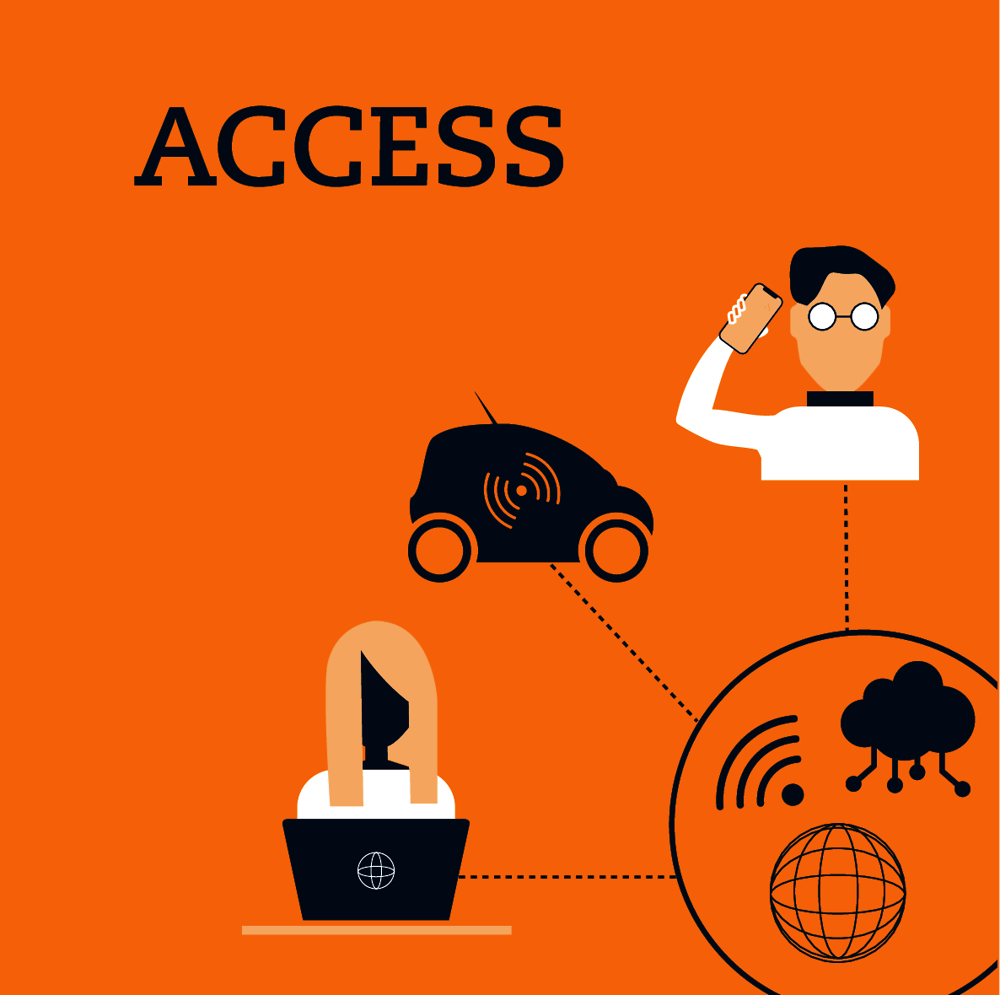Chapter 1. Going digital: An integrated approach to policy making in the digital age
The Going Digital Integrated Policy Framework helps countries develop a co-ordinated, whole-of-government approach to digital transformation. It includes seven interrelated dimensions: access, use, innovation, jobs, society, trust and market openness.
Good policies in all of these dimensions are needed to make digital transformation work for growth and well-being. Cross-cutting issues such as gender, skills, digital government and data governance also need to be taken into account.
The COVID-19 crisis reinforces the need for an inclusive approach to digital transformation. As the health and economic crisis has evolved, the trade-offs between policy objectives may have changed.
Re-evaluating existing digital policies should involve establishing a governance approach that supports co-ordination, articulating a strategic vision, assessing key digital trends and policies, and developing and implementing a comprehensive strategy.
Designing and implementing well-suited policies for the digital age is a complex challenge, but one that can produce many benefits. This chapter introduces the Going Digital Integrated Policy Framework (hereafter “the framework”), which helps countries shape policies for an inclusive digital future. The framework recognises technologies, data and business models as driving forces underlying digital transformation (OECD, 2019[1]).
To that end, it builds on the cross-cutting analysis of “vectors” of digital transformation across many different policy domains (OECD, 2019[2]). The framework applies to both OECD countries and partner economies. It also underpins the OECD Going Digital Toolkit,1 which provides interactive data visualisations and access to key indicators, analysis and policy guidance.
The framework includes seven interrelated policy dimensions: access, use, innovation, jobs, society, trust and market openness (Figure 1.1). Each of the dimensions brings together multiple policy domains that need to be considered jointly, rather than as separate policy silos. Leveraging the benefits and addressing the challenges of digital transformation require co-ordination across all policy domains identified by the framework. They also demand consideration of transversal policy issues (e.g. gender, skills, digital government and data governance) that cut across the seven dimensions (OECD, 2020[3]). All policy dimensions must be considered to make digital transformation work for growth and well-being.
The COVID-19 crisis reinforces the need for a co-ordinated, whole-of-government policy approach to digital transformation as outlined in the framework. Indeed, as the health and economic crisis has evolved, the trade-offs between policy domains may have changed. This requires a balancing act that will not be the same for all countries, as cultural, social and economic factors influence the most suitable policy environment. The framework is designed to help countries strike the right balance, make better policies in the digital age and ensure no one is left behind (OECD, 2020[3]). The pandemic also underscores the importance of a multi-stakeholder approach to digital policy making.
This chapter explores the framework’s seven dimensions and the policy domains contained therein. It also identifies key policy actions and guidance for each one. It concludes by describing how to put the framework into practice; further insights on national digital strategies are discussed in Chapter 2.

Investment
Communications infrastructures and services
Competition
Regional development
Explore key indicators on Access on the interactive Going Digital Toolkit: www.oecd.org/going-digital-toolkit.
Communications infrastructures and services underpin the use of digital technologies, and facilitate interactions between connected people, organisations and machines. They serve as the basis for an open, interconnected and distributed Internet that enables the global free flow of information. High-quality access to communication networks and services at competitive prices is fundamental to digital transformation.
Data are emerging as a similarly vital resource. Data are a driver of economic activity and a general-purpose input into production in many contexts, but the benefits are predicated on data availability and accessibility. Enhancing access to and the sharing of data is thus important, although such decisions should be balanced with considerations of data privacy and security, among others. Governments can enhance access in four key ways.
Policy makers can promote investment in communications infrastructures, especially broadband networks, by encouraging the deployment of more fibre into networks to drive a substantial increase in speeds across technologies. Among OECD countries, the private sector invests the highest share in communications infrastructures and services. However, governments sometimes support such investments when it is not economically feasible otherwise. To spur further investment in networks, policy makers should address barriers to investment and improve competitive dynamics. Some important barriers include the availability or uptake of key technical enablers, including Internet exchange points (IXPs), spectrum and IPv6 addresses.
Communications infrastructures and services policies are crucial to foster high-speed infrastructure deployment. For example, simplifying licence requirements, removing regulatory uncertainty and facilitating efficient access to rights of way can all help spur investment. These regulatory issues may gain increased significance in light of next-generation wireless networks (“5G”) (OECD, 2019[4]). In some countries, a lack of related infrastructure such as electricity, roads and ports can act as a significant barrier to investment. Removing undue restrictions on foreign investment can also spur investment in infrastructure.
Policy makers should also boost competition in communications infrastructures and services markets to spur private investment and help to deploy fibre further into fixed networks. This can support increases in speed and capacity across all next-generation technologies, including 5G networks (OECD, 2019[4]). Competition among infrastructure and service providers influences investment and pricing decisions. This can drive up the quality and speed of broadband, including to underserved populations. Competition policies should ensure that users benefit from greater choice in services from network and service providers, either through bundled or simple voice, data and video offers.
Regional development policies are important to address digital divides, namely differences in access to broadband in urban, semi-urban, rural and remote areas. Governments may choose to solve critical bottlenecks to needed private investment in rural areas by investing in high-speed backbones or backhaul infrastructures (OECD, 2017[5]), Often, government investment is conditional on open-access policies to avoid encouraging monopolies in underserved areas (OECD, 2017[6]).
Alongside communications infrastructures and services, access to data that flows through such infrastructures is increasingly important because data is a key source of value, and its effective and innovative use and re-use can spur economic and social benefits. However, these benefits – ranging from innovative applications to increased transparency and accountability – are predicated on the availability of data. As a result, enhancing access to and the sharing of data is a critical policy concern in the digital age (OECD, 2019[7]).
Promote competition to drive investment in communications infrastructures and services. Depending on local market conditions, the presence of more mobile network operators (e.g. four rather than three) can result in more competitive and innovative services. Passive infrastructure sharing and co-investment can also help extend coverage.
Ensure technical enablers are in place, such as Internet exchange points, efficient allocation of spectrum and new generation Internet protocol addresses. Reduce administrative barriers to investment, such as burdensome licensing requirements and complex rights of way.
Boost connectivity in rural and remote areas, for example by investing directly in high-speed fixed networks or incentivising private investment. This could include competitive tendering, tax exemptions, low interest loans, public support or lower spectrum fees.
Enhance access to and sharing of data, while balancing its benefits and risks, taking into account legitimate national, commercial, private and security interests through, for example, contractual agreements, restricted data-sharing arrangements, data portability and open government data.
Source: OECD (2019[1]), Going Digital: Shaping Policies, Improving Lives, https://dx.doi.org/10.1787/9789264312012-en.

Digital government
Investment
Business dynamism
Small and medium enterprises
Skills
Digital security and privacy
Explore key indicators on Use on the interactive Going Digital Toolkit: www.oecd.org/going-digital-toolkit.
Harnessing the power and potential of digital technologies depends on how they are used. Effective use enables individuals to participate in society, firms to boost productivity, and governments to go digital and adopt a user-driven approach. Widespread diffusion and effective use of digital technologies and data require awareness of the opportunities they bring, business dynamism, investment in information and communication technologies (ICTs) and complementary assets, especially skills. At the same time, policies need to strengthen trust in digital environments, for example, by empowering people and organisations to better manage digital risk.
Digital government strategies help ensure a more comprehensive approach to digital transformation of the government and the public sector (OECD, 2014[8]). Most OECD countries have digitised some aspects of public service delivery (e.g. public procurement and tax collection). However, large cross-country variations persist. Much potential remains for more comprehensive digital government approaches. This includes using digital technologies to digitise analogue processes and services; reorganising administrative procedures to make them digital by design; making user needs drivers of change; and opening up government data. In addition, countries are increasingly adopting a “mobile first” approach to digital government.
Unleashing the potential of digital tools for firms to increase productivity requires successful diffusion, which crucially depends on firms’ investment in ICTs as well as public investment in infrastructure and equipment. Countries promote ICT investment through monetary support or incentives to buy ICT equipment or services, as well as non-financial support (e.g. targeted training), among others2 (OECD, 2019[9]). Effective use of technologies further requires firms’ investment in complementary assets, knowledge-based capital (KBC) in particular. KBC assets include research and development (R&D), data, organisational capital and skills.
Technology diffusion is linked to business dynamism, which depends on efficient resource allocation. Digital transformation of firms involves experimentation and learning. Some firms successfully adopt digital tools and rapidly scale up, while others scale down or exit the market (Andrews and Criscuolo, 2013[10]). Business dynamism can benefit from structural reforms. Several policies can affect competitive pressure and business dynamism, and in turn technology diffusion and better resource allocation. These include labour market regulations, employment protection legislation and the design of insolvency regimes. For example, governments could enact less penalising sanctions for bankruptcy and lower barriers for corporate restructuring of insolvent firms (Andrews, Nicoletti and Timiliotis, 2018[11]; Adalet McGowan and Andrews, 2018[12]; Sorbe et al., 2019[13]).
Effective use of digital tools is increasingly essential for small and medium-sized enterprises (SMEs) to improve business processes, innovate, scale up and internationalise. However, SMEs lag behind large firms in the adoption of digital tools and, crucially, in the use of advanced ones. Key barriers include lack of awareness; limited collateral to take risk and access finance for investing in ICTs and complementary assets; and a lack of human resources and capabilities (e.g. ICT specialists). To help overcome these barriers, governments need to better target policies3 to SMEs (OECD, 2019[1]).
Technology diffusion and effective use crucially depend on skills (Andrews, Nicoletti and Timiliotis, 2018[11]). The success of firms in the digital age depends on workers with good literacy, numeracy, problem solving and generic ICT skills4 used at work.5 Increasingly, it also requires ICT specialists6 and data specialists.7 In addition, firms require complementary skills and competences8 for new organisational forms and in digital-intensive sectors. Ensuring the provision of relevant skills for the digital age requires investments in education and training. Primary education needs to deliver sound literacy and numeracy skills. Subsequently, students need options to develop ICT and complementary skills, including social, communication and management skills. In addition, many forms of learning can benefit from the use of digital technologies (OECD, 2019[14]).
Mistrust in digital technologies can be an important barrier to diffusion and effective use. In particular, concerns about digital security and privacy can severely hamper individuals’ propensity to engage on line. For businesses as well, trust is a key factor affecting the adoption and use of digital tools. Governments may also face privacy issues, for example when linking data sets or when opening up government data to the public. Addressing these barriers requires all actors to better manage digital risk. This involves building capacities to assess digital risk and reduce it to an acceptable level, including through risk mitigation and/or transfer.
Close the usage gap between those with high versus low education levels and empower everyone with a mix of skills to thrive and trust in a digital world. To do so, review education and training systems to better exploit the possibilities of digital learning.
Boost diffusion of digital tools to drive productivity growth in firms, and small and medium-sized enterprises in particular. To do so, promote investment in digital technologies and intangible assets (e.g. patents, software) and foster business dynamism and structural change that encourages adoption.
Shift from an e-government to a holistic and user-driven digital government approach. At the same time, continue to improve online public services and ensure coherent use of digital technologies and data across all parts and levels of government.
Address mistrust to increase online engagement by raising awareness and empowering people and businesses to better manage digital risks.
Source: OECD (2019[1]), Going Digital: Shaping Policies, Improving Lives, https://dx.doi.org/10.1787/9789264312012-en.

Entrepreneurship
Small and medium enterprises
Competition
Science and technology
Digital government
Sectoral policies and regulations
Explore key indicators on Innovation on the interactive Going Digital Toolkit: www.oecd.org/going-digital-toolkit.
Digital innovation is a fundamental driver of digital transformation, leading to radical changes in the ways people interact, create, produce and consume. Digital innovation not only gives rise to new goods and services, but it also creates opportunities for new business models and markets, and it can drive efficiencies in the public sector and beyond. Digital technologies and data spur innovation in a wide range of sectors, including education, health, finance, insurance, transportation, energy, agriculture, fisheries and manufacturing, as well as the ICT sector itself.
Since young firms are an essential part of the digital innovation landscape, promoting digital innovation requires a focus on entrepreneurship and SME policies that encourage the emergence and growth new and young firms. Helping entrepreneurs start innovative businesses also requires attention to structural factors that facilitate new ventures and do not excessively penalise entrepreneurial failure (Adalet McGowan, Andrews and Millot, 2017[15]). In addition, organisations need to invest in KBC. This is essential for innovative business models and new organisational forms that raise the premium associated with complementary skills. Digital technologies can help improve access to finance of SMEs and start-ups through innovative instruments like crowdfunding (OECD, 2019[16]).
Market concentration in a digitalised economy can represent another barrier to innovation, underscoring the importance of competition policies. Regulatory frameworks can constrain the entry of new players, which is essential for driving competition, innovation and technological diffusion across the economy. For example, regulations that require a physical presence can constrain the emergence of online intermediary businesses (OECD, 2018[17]). Similarly, the high regulatory burden in some industries, such as banking, can create costs that only incumbent firms of a certain size can afford. This constrains the emergence of smaller, often digitally enabled, business models.
Digital innovation relies on continuously building the knowledge base, and basic research into science and technology is critical in this respect. Public support for universities and other institutions conducting basic research can help sow the seeds of future innovation. The public sector also helps drive innovation beyond research through partnerships between universities, industry and government. These can provide start-ups with the know-how, equipment and initial funding to test and scale new technologies. Well-designed incentives to support R&D and innovation can be helpful in this regard. Such incentives include the protection of intellectual property regimes and tax-based incentives such as R&D tax credits. Open Science9 initiatives can also be useful for boosting digital innovation (OECD, 2015[18]).
Digital government strategies, and open government data in particular, can drive innovation and efficiencies in the public sector and beyond. Digital technologies can help governments to better develop, design and enforce policies and regulations; become more efficient; and reduce waste. As the public sector both produces and consumes large amounts of data, there is significant potential for governments to use this data and digital technologies to innovate.
The pace of digital transformation varies across sectors. Perhaps unsurprisingly, the ICT sector and the telecommunication sector appear to have incorporated digital assets and know-how across the breadth of their businesses. However, ICT services outstrip their manufacturing counterparts. Looking ahead, digital technologies, such as data analytics and artificial intelligence (AI), offer vast potential to improve productivity in service activities. This includes enhancements in less knowledge-intensive activities such as personal transport and accommodation where productivity has traditionally been sluggish (Sorbe, Gal and Millot, 2018[19]). Connecting historical patient data with real-time patient data and using connected devices, for example, could drive increasingly personalised care and sector-wide innovation in the health sector.
Boost entrepreneurship by reducing regulatory burdens for start-ups and facilitating access to finance for new and young firms through a mix of venture capital, debt and equity financing, and digital financing solutions such as platform-based lending.
Re-evaluate regulations that may not be fit for the digital age, such as those that require a physical presence or minimum scale, or seek to address information asymmetries.
Incentivise investment in basic R&D and intangible assets, including skills, organisational capital, data, software and patents, such as through R&D tax credits and intellectual property systems that are well-suited to the digital age.
Foster knowledge diffusion through open innovation and open science initiatives, and promote open government data through, for example, “open by default” policies, to stimulate innovation across the economy.
Encourage policy experimentation and new business models across sectors, including through agile regulation and flexible application or enforcement of regulation (e.g. regulatory “sandboxes”), while protecting consumers.
Sources: OECD (2019[1]), Going Digital: Shaping Policies, Improving Lives, https://dx.doi.org/10.1787/9789264312012-en; Attrey, Lesher and Lomax (2020[20]), “The role of sandboxes in promoting flexibility and innovation in the digital age”, https://goingdigital.oecd.org/toolkitnotes/the-role-of-sandboxes-in-promoting-flexibility-and-innovation-in-the-digital-age.pdf.

Labour markets
Skills
Social protection
Tax and benefit systems
Regional development
Explore key indicators on Jobs on the interactive Going Digital Toolkit: www.oecd.org/going-digital-toolkit.
Digital transformation has already begun to change organisations and markets, raising important questions. Which jobs might disappear? Where will new ones come from? What will they look like? Which skills will be required? At the same time, other questions have emerged. Who might be most affected? What can be done to foster job creation and align skills development with the changing skills requirement of new jobs? Social partners can play an important role in answering such questions.
Maintaining and improving labour market performance in a digital world of work requires a fresh look at labour market regulations. This includes employment protection legislation, minimum wage laws, work time regulations and regulations to safeguard occupational health and safety, among others (OECD, 2019[21]). Digital transformation may continue to promote non-standard forms of work, resulting in job and income security for some such workers. Countries must determine whether legal frameworks need updating or adjusted to remain fit for purpose. Such frameworks should ensure that all workers – regardless of contract type – receive adequate rights, including freedom to association and bargaining, equal pay for equal work, benefits and protections.
People need the right mix of skills to prepare for future jobs. The evolution of skills required to thrive in a highly digital economy and society remains uncertain. However, the mix of crucial skills include literacy, numeracy and problem solving, ICT generic skills, as well as complementarity skills and competences (e.g. creative thinking and team work). An effective response to these skill needs requires a holistic approach to skills development – from early childhood education to lifelong learning. The training investment required to meet future needs goes beyond the capacity of the public sector, with firms and individuals also implicated. Training should target those most in need, who are often low-skilled workers. Online courses, such as massive open online courses (MOOCs), also offer flexible and affordable options for distance education in several areas. However, skills certification and recognition outside of formal education still pose a challenge (OECD, 2019[14]).
Social protection is crucial to enable successful and fair transitions for all, including displaced workers. Some workers will want to transition into new occupations. Others will try to enter the labour market for the first time or after a spell of unemployment. In both cases, they may not find a new job immediately. Helping these workers involves a system of well-designed and adequately resourced active and passive labour market programmes. These approaches provide workers with timely access to basic job search services and target those that require more extensive assistance. Many people work informally and are not protected under existing rules. All this adds to the challenges faced by social security systems, which still largely assume a full-time, regular, open-ended contract with a single employer.
Governments also need to extend and/or adapt tax and benefit systems to ensure all workers receive minimum protection and wages, and that their various sources of income are brought into the tax system. Tax and benefit systems should promote portability of social security entitlements to prevent the loss of benefit entitlements when workers move between jobs. Governments may also need to expand the role of non-contributory schemes so no one is left without social protection as a result of their contract status.
Regional development policies are needed to address geographical disparities that emerge because of digitally induced job creation and automation (Sorbe, Gal and Millot, 2018[19]). Reducing the costs of relocation, for example through subsidies, is one way to enhance labour mobility and help displaced workers transition back into employment. In addition, well-designed housing policies can encourage people to move into regions where more and better jobs are available (Andrews, Caldera Sánchez and Johansson, 2011[22]; OECD, 2015[23]).
Promote successful and fair transitions from declining to expanding jobs by striking a balance between flexibility and mobility (including through wage incentives for workers to move from low- to high-productivity firms) and job stability (including through dialogue with social partners).
Review labour market policies and institutions to ease firms’ workforce adjustment and to facilitate job-to-job transitions for workers. Providing adequate protection through better transferability of skills, portability of benefits and effective employment services.
Ensure people have the right mix of skills to succeed in technology-rich work environments, notably sound cognitive skills, ICT skills, complementary skills, specialist skills and the ability to cope with change and keep learning, including when out of work. Co-ordinate among education and training institutions, employers and social partners.
Get ready for a massive training challenge and review education systems. Improve the accessibility, quality and equity of education for young people and of training for adults throughout their working life, including through addressing barriers to adult learning, training incentives for those most in need, and better use of digital technologies for learning.
Address concerns around emerging forms of work and ensure good outcomes for all workers by applying and, where needed, reviewing and extending labour market regulation, and strengthening workers’ voices. Reduce the risk of arbitrage between different forms of employment and work by ensuring neutrality of regulation, tax systems and benefit schemes.
Improve social protection to ensure nobody is left behind. Strengthen active labour market programmes to support displaced workers and design effective income support schemes to provide income security without undermining work incentives.
Source: OECD (2019[1]), Going Digital: Shaping Policies, Improving Lives, https://dx.doi.org/10.1787/9789264312012-en.

Social policies
Skills Tax and benefit systems
Environment Health care
Digital government
Explore key indicators on Society on the interactive Going Digital Toolkit: www.oecd.org/going-digital-toolkit.
Digital transformation affects society and culture in complex ways. First, digital technologies dramatically change the ways in which individuals, firms and governments interact. In addition, overall impacts are often not clear-cut and may vary across countries. For example, digital technologies enhance access to information (a free and interconnected Internet), improve health care (e.g. telemedicine) and enrich education (e.g. MOOCs). On the other hand, challenges arise related to work-life imbalances; the segregation of people into relatively isolated, like-minded groups; negative mental health outcomes such as screen addiction, depression and cyberbullying, including among children; and the emergence of digital divides (e.g. gender, skills).
Social policies can help address a range of digital divides. When knowledge-intensive firms cluster in places with high-skilled workers, for example, place-based social policies can help address geographic divides (Moretti, 2012[24]; Berger and Frey, 2015[25]; OECD, 2018[26]). Digital tools can also help governments make better social policy choices and improve well-being. Linking longitudinal and multi-domain data about individuals, families, and the environment, for example, can provide insight into the impact of policies on communities.
Skills development throughout the life cycle, especially through education and training policies, can ensure that digital transformation benefits all and avoids exacerbating existing divides. Skills development involves a range of foundational competences, including literacy, numeracy and problem-solving skills (see “Use”). It also embraces social and emotional skills that are increasingly valued by employers and more generally by society. Approaches to develop such “soft skills” include working with students’ feelings and relationships through role playing, collaborative-based pedagogies, gaming, case studies, problem-solving pedagogies, sports and the arts (Le Donné, Fraser and Bousquet, 2016[27]).
As economies and societies change and adjust, redistribution policies such as tax and benefit systems ensure no one is left behind. Redistribution through income support has declined across the OECD alongside a decline in the share of personal income taxes. However, higher aggregate spending on policies like health care has partially offset this change (Causa and Hermansen, 2017[28]). Governments may also need to reconsider redistribution patterns in light of changes to organisations and the nature of work (Causa, Vindics and Akgun, 2018[29]).
Digital technologies likewise present challenges and opportunities for tackling some great, collective challenges such as the environment and health care. With respect to the environment, digital technologies can support green growth. For example, they can enable efficiencies and monitoring in “smart” infrastructures and cities. However, the widening range and rapid diffusion of digital technologies may also increase resource and energy demands in production and use. This would offset some environmental gains, resulting in greater need for recycling and disposal of old equipment.
With respect to health care, digitising health records, expanding tele-care and tele-consultation, and implementing mobile health technologies can improve health care and potentially reduce costs. However, data-driven health services also raise new challenges. These relate primarily to personal data protection and privacy, security, control and ownership, transparency and accountability, and quality and safety. Good governance of sensitive health data can address many of these concerns.
Digital government can empower users to access digital public services at their convenience and in new ways. Citizens can enjoy enhanced interaction with public administrations within and across tiers of government, for example. Where service provision is fragmented across disparate public agencies, governments can embrace the “once only” principle.10 This would reduce the burden for citizens and businesses of having to provide the same information multiple times. In addition, digital one-stop-shops can ease access to information and assistance, such as for job seekers. Governments can also gather more detailed information through interacting with citizens on line to personalise public services and better target public policies.
A range of social issues has emerged or become heightened as digital transformation progresses, including questions about ethics and morality. For example, AI, machine learning and autonomous decision making raise new questions about transparency (possible biases and discrimination), responsibility and accountability. Disinformation11 has also gained attention. Some argue it negatively affects individuals and society (European Commission, 2018[30]; DCMS Committee, 2018[31]; Ministry of Foreign Affairs of Denmark, 2018[32]; Pamment, Nothhaft and Agardh-Twetman, 2018[33]).
Reduce digital divides and include everyone in a digital society, notably women, the elderly and low-income individuals, including through social policies that support mobility and redistribution.
Promote foundational skills for all, including by offering incentives for and easing access to adult learning and improving the recognition of skills acquired after initial education.
Harness the potential of digital technologies and data to address collective challenges, such as environmental protection and health care, by promoting energy efficiency and reducing health care costs with mobile health technologies.
Boost civic engagement through digital government strategies and involve all stakeholders, including the technical community, the business community, trade unions and civil society, to help understand and address societal issues such as risks like cyberbullying and disinformation.
Source: OECD (2019[1]), Going Digital: Shaping Policies, Improving Lives, https://dx.doi.org/10.1787/9789264312012-en.

Digital risk management
Small and medium enterprises
Privacy
Digital security
Consumer protection
Explore key indicators on Trust on the interactive Going Digital Toolkit: www.oecd.org/going-digital-toolkit.
To fully embrace and benefit from digital transformation, individuals, firms and governments need to be confident that the digital environment will bring more benefits than downsides for their social and economic activities. The digital environment could exacerbate digital security incidents, information asymmetries, power imbalances or jurisdictional challenges. These may translate into breaches of laws and regulations such as privacy, consumer protection or product safety that are intended to reduce these imbalances and challenges. Such uncertainties must be mitigated as much as possible to ensure trust.
Digital risk management applies to individuals, as well as to organisations – from small and large businesses to public entities. All actors share some responsibility to manage the digital risks of their activities. This will vary according to their roles, ability to act, context and the need to be equipped with the right skills to manage the risks. Risk is a cross-boundary, cross-sectoral and multi-stakeholder issue. As such, digital risk management provides a common reference framework for different policy communities to discuss trust policies in an integrated manner. It also enables different actors to address risks in a more holistic way, building on the fundamental components of a risk management cycle.
SMEs, and start-ups in particular, are critical to economic growth in contributing to competition, innovation and job creation. However, they also face distinct challenges in managing digital risk. Typically, SMEs lack the awareness, resources or expertise to assess and manage risk effectively. To help SMEs realise opportunities from digital transformation, they need more awareness of good practices in digital risk management.
As digital transformation progresses, privacy is emerging as a critical factor influencing trust, especially the protection of personal data. Privacy is recognised as a fundamental value that merits protection, as well as a condition for the free flow of personal data across organisations and borders (OECD, 2016[34]). Technological advances can help increase trust through “privacy by design”, which considers privacy implications at the initial design phase of a product or service.
While technology can help, it cannot replace a strategic approach to protect privacy and personal data. One example is a national data strategy, supported at the highest level of government, which incorporates a whole-of-society perspective and balances individual and collective interests. Interoperability of privacy and data protection frameworks at the national and international levels needs to be fostered internationally.
Given it is impossible to create an entirely safe and secure digital environment, businesses, other organisations and individuals always take some digital security risk when engaging on line. Security standards (e.g. ISO 27000 series) can increase resilience and maintain business continuity by mitigating the potential consequences of security incidents. All stakeholders are interdependent in the digital environment, including across borders. Consequently, fostering partnerships, including with SMEs, can help reduce risk and promote good risk management. Cyber insurance can be an important element of managing digital security risk. It can enable the transfer of some risk, while creating incentives for better risk management.
For digital transformation to flourish, it is important to protect consumers effectively when they are engaged in e-commerce and other online activities. Transactions involving digital content and services (including zero price activities that involve users’ data) and blurred boundaries between consumers and businesses can also complicate traditional ideas of ownership, liability, rights and obligations.
Key challenges relate to information disclosure, misleading and unfair commercial practices, confirmation and payment, fraud and identity theft, product safety, and dispute resolution and redress. Novel forms of asset and content usage, including through rental, asset sharing and subscription services, pose challenges for consumer understanding of their rights and obligations. In financial markets, individuals (notably those with low levels of digital literacy) need new skills and knowledge to use new digital products and services effectively, and to understand the potential ramifications of sharing data.
Use risk management as a framework to develop policies to increase trust, including to assess and manage risks related to digital technologies, data and cross-border flows. Ensure digital security risk goes beyond technical questions to become a strategic priority for individuals, firms – small and medium-sized enterprises in particular – and governments, and that everyone takes responsibility for managing digital risk.
Develop and implement a national privacy strategy with a whole-of-society perspective supported at the highest level of government. Encourage interoperability of privacy frameworks across jurisdictions to enable the free flow of personal data; increase transparency on the purpose and use of personal data collections; and enhance users’ access and control over their data, including through “privacy by design”.
Support digital consumers who face challenges related to online information disclosure, misleading and unfair commercial practices, confirmation and payment, fraud and identity theft, product safety, and dispute resolution and redress, including in the context of connected devices where the offline and online worlds converge.
Source: OECD (2019[1]), Going Digital: Shaping Policies, Improving Lives, https://dx.doi.org/10.1787/9789264312012-en.

Trade
Investment
Financial markets
Competition
Taxation
Explore key indicators on Market Openness on the interactive Going Digital Toolkit: www.oecd.org/going-digital-toolkit.
Digital technologies are transforming the environment in which firms compete, trade and invest. Market openness enables digital transformation to flourish by creating a business-friendly environment. This allows foreign and domestic firms to compete on an equal footing and without excessive restrictions or regulations. Market openness policies related to trade, investment, financial markets, competition and taxation play an important role in this respect.
Digital technologies and data profoundly affect international trade by reducing trade costs; facilitating the co-ordination of global value chains; diffusing ideas and technologies across borders; and connecting greater numbers of businesses and consumers globally. In particular, goods are increasingly bundled with services, and new and previously non-tradeable services are now traded across borders. Reaping the benefits of trade in the digital age requires multi-stakeholder dialogue on regulatory approaches. These approaches should ensure the interoperability of differing regulatory regimes, particularly for transversal issues such as cross-border data flows.12 To support this dialogue, the nature and composition of heterogeneous data flows must be better understood, and the scope of public policy objectives should be clarified.
Investment regimes that mobilise private investment, including in communications infrastructures, technologies, and KBC (e.g. business models, software and data), coupled with open financial markets, attract foreign direct investment (FDI). Multinational enterprises – which by definition operate across borders – can make extensive use of digital technologies and data to organise their business operations and improve processes and procedures (see “Use”). Use of such technologies also promotes market-based international technology transfer (Lesher and Miroudot, 2008[35]).
Efficient, stable and open financial markets, based on transparency, confidence and integrity, help allocate financial resources to firms investing in digital transformation. Open financial markets also ensure that domestic financial services firms can compete with foreign competitors. Increased competition should make domestic firms more efficient and transparent. Financial flows can lower the cost of capital for firms in countries in which capital is scarce. This, in turn, can raise investment in digital transformation. Digital technologies also underpin new forms of external funding (e.g. crowdfunding13).
Strengthening competition in the digital age, including by opening access to markets, benefits consumers through lower prices and a greater variety of goods and services. This, in turn, supports trade and investment. Competitive markets also underpin digital transformation by spurring innovation, new business models, business dynamism and productivity, driving structural change across the economy. However, as digital technologies and data lead to greater competition in many markets, they have also demonstrated a potential to tilt others towards greater concentration, market power and even dominance. The OECD Competition Assessment Toolkit helps governments eliminate barriers to competition by identifying unnecessary restraints on market activities and developing alternative, less restrictive measures (OECD, 2020[36]).
Digital transformation has a wide range of implications for taxation. It affects tax policy and tax administration at both domestic and international levels, introducing new tools and challenges for policy makers. Work under the OECD/G20 Base Erosion and Profit Shifting (BEPS) Project and the Inclusive Framework on BEPS has recognised that digitalisation – and some of its related business models – present important challenges for international taxation (OECD, 2015[37]; OECD, 2018[38]).
Members of the Inclusive Framework on BEPS have agreed to undertake a coherent and concurrent review of the two key aspects of the existing tax framework – the profit allocation and nexus rules. This review would consider the impacts of digitalisation on the economy, relating to the principle of aligning profits with underlying economic activities and value creation.14
Monitor changing competitive dynamics, especially trends in market concentration and dominance in digital-intensive sectors, and ensure that competition authorities use flexible tools and co-operate across borders to address transnational competition issues.
Lower trade barriers, particularly for digitally deliverable services, e.g. inefficient regulations on interconnection. Ensure holistic market openness policies through multi-stakeholder dialogue to ensure interoperability across regulatory regimes, including for cross-border data flows and related privacy and security considerations.
Reduce barriers to international investment, including in communications infrastructures, digital technologies and knowledge-based capital (e.g. business models, software, data), and promote open financial markets.
Ensure that tax systems are fit for purpose in the digital age through continued international co-operation towards a consensus-based, global solution.
Source: OECD (2019[1]), Going Digital: Shaping Policies, Improving Lives, https://dx.doi.org/10.1787/9789264312012-en.
A whole-of-government approach to digital transformation requires a digital transformation strategy (DTS). Many countries have a national digital strategy or an equivalent policy in place (see Chapter 2), but most are still narrow in scope. A DTS should be comprehensive in addressing the range of interrelated policy issues discussed above. It should ensure coherence and co-ordination of policies across all domains and sectors that shape digital transformation. Finally, it should involve all relevant stakeholders in its development and implementation. There are five key steps to develop a DTS (Box 1.8).
1. Establish a governance approach that supports effective co-ordination.
Establish a governance approach that supports effective steering and co-ordination of digital transformation policies in light of the country’s culture and institutions.
Assign clear responsibilities for strategic co-ordination (e.g. the head of government or a lead minister) and operational co-ordination (e.g. chief digital officers in implementing bodies) for development and implementation of a national digital transformation strategy (DTS).
2. Articulate a strategic vision and ensure coherence.
Articulate a strategic vision that provides direction on identifying the main priorities and scoping the main objectives of a DTS.
Ensure coherence between a DTS and other related domestic and international digital strategies and/or policy objectives.
3. Assess key digital trends, related policies and regulations.
Monitor key digital trends, including by international benchmarking, to identify opportunities and challenges and related priorities to be addressed by a DTS.
Evaluate the effectiveness of current strategies and/or policies, identify gaps and/or incoherence, and scope objectives for a DTS.
4. Develop a comprehensive and coherent strategy.
Leverage the governance approach, the strategic vision, and insights from monitoring and evaluation to develop a comprehensive and coherent DTS.
Engage all relevant actors in developing a DTS, including different parts and levels of government, non-governmental stakeholders and international partners.
5. Implement the strategy successfully.
Anticipate and address implementation challenges related to institutions and policy frameworks, social preferences and (lack of) administrative capacity.
Issue an action plan with specific measures, clear responsibilities, budget, timeframes and measurable targets to successfully implement the DTS.
Source: (OECD, 2019[1]), Going Digital: Shaping Policies, Improving Lives, https://dx.doi.org/10.1787/9789264312012-en.
Government actors who draft a strategy and design policies can never by themselves have a full understanding of all opportunities, challenges and issues related to a DTS. One key to success is thus engaging stakeholders from the early stages of strategy and policy development. Multi-stakeholder co-operation brings tangible benefits that lead to better policies and outcomes. It improves the quality of rulemaking through ideas, expertise and evidence from stakeholders. Furthermore, it creates a sense of ownership in and enhances the legitimacy of policies and regulations. In turn, stakeholder engagement can increase trust in government and compliance with regulations.
References
[12] Adalet McGowan, M. and D. Andrews (2018), “Design of insolvency regimes across countries”, OECD Economics Department Working Papers, No. 1504, OECD Publishing, Paris, https://dx.doi.org/10.1787/d44dc56f-en.
[15] Adalet McGowan, M., D. Andrews and V. Millot (2017), “The Walking Dead?: Zombie Firms and Productivity Performance in OECD Countries”, OECD Economics Department Working Papers, No. 1372, OECD Publishing, Paris, https://dx.doi.org/10.1787/180d80ad-en.
[22] Andrews, D., A. Caldera Sánchez and Å. Johansson (2011), “Housing Markets and Structural Policies in OECD Countries”, OECD Economics Department Working Papers, No. 836, OECD Publishing, Paris, https://doi.org/10.1787/5kgk8t2k9vf3-en.
[10] Andrews, D. and C. Criscuolo (2013), “Knowledge-Based Capital, Innovation and Resource Allocation”, OECD Economics Department Working Papers, No. 1046, OECD Publishing, Paris, https://dx.doi.org/10.1787/5k46bj546kzs-en.
[11] Andrews, D., G. Nicoletti and C. Timiliotis (2018), “Digital technology diffusion: A matter of capabilities, incentives or both?”, OECD Economics Department Working Papers, No. 1476, OECD Publishing, Paris, https://doi.org/10.1787/7c542c16-en.
[20] Attrey, A., M. Lesher and C. Lomax (2020), “The role of sandboxes in promoting flexibility and innovation in the digital age”, Going Digital Toolkit Policy Note, No. 2, https://goingdigital.oecd.org/toolkitnotes/the-role-of-sandboxes-in-promoting-flexibility-and-innovation-in-the-digital-age.pdf.
[25] Berger, T. and C. Frey (2015), “Industrial renewal in the 21st century: Evidence from US cities”, Regional Studies, Vol. 51/3, pp. 404-413, https://doi.org/10.1080/00343404.2015.1100288.
[28] Causa, O. and M. Hermansen (2017), “Income redistribution through taxes and transfers across OECD countries”, OECD Economics Department Working Papers, No. 1453, OECD Publishing, Paris, https://doi.org/10.1787/bc7569c6-en.
[29] Causa, O., A. Vindics and O. Akgun (2018), “An empirical investigation on the drivers of income redistribution across OECD countries”, OECD Economics Department Working Papers, No. 1488, OECD Publishing, Paris, https://doi.org/10.1787/5cb47f33-en.
[31] DCMS Committee (2018), “Disinformation and ‘fake news’: Interim report”, Fifth Report of Session 2017-19, Digital, Culture, Media and Sport Committee, House of Commons, United Kingdom, https://publications.parliament.uk/pa/cm201719/cmselect/cmcumeds/363/363.pdf.
[30] European Commission (2018), “A multi-dimensional approach to disinformation”, Report of the Independent High Level Group on Fake News and Online Disinformation, European Commission, Brussels, http://ec.europa.eu/newsroom/dae/document.cfm?doc_id=50271.
[27] Le Donné, N., P. Fraser and G. Bousquet (2016), “Teaching Strategies for Instructional Quality: Insights from the TALIS-PISA Link Data”, OECD Education Working Papers, No. 148, OECD Publishing, Paris, https://doi.org/10.1787/5jln1hlsr0lr-en.
[35] Lesher, M. and S. Miroudot (2008), “FDI Spillovers and their Interrelationships with Trade”, OECD Trade Policy Papers, No. 80, OECD Publishing, Paris, https://dx.doi.org/10.1787/235843308250.
[32] Ministry of Foreign Affairs of Denmark (2018), “Strengthened safeguards against foreign influence on Danish elections and democracy”, webpage, https://um.dk/en/news/newsdisplaypage/?newsid=1df5adbb-d1df-402b-b9ac-57fd4485ffa4 (accessed on 19 October 2019).
[24] Moretti, E. (2012), The New Geography of Jobs, Houghton Mifflin Harcourt, Boston.
[3] OECD (2020), “Going Digital integrated policy framework”, OECD Digital Economy Papers, No. 292, OECD Publishing, Paris, https://dx.doi.org/10.1787/dc930adc-en.
[36] OECD (2020), “OECD Competition Assessment Toolkit”, webpage, https://www.oecd.org/competition/assessment-toolkit.htm (accessed on 21 October 2020).
[7] OECD (2019), Enhancing Access to and Sharing of Data: Reconciling Risks and Benefits for Data Re-use across Societies, OECD Publishing, Paris, https://dx.doi.org/10.1787/276aaca8-en.
[16] OECD (2019), “Enhancing SME access to diversified financing instruments”, in Strengthening SMEs and Entrepreneurship for Productivity and Inclusive Growth: OECD 2018 Ministerial Conference on SMEs, OECD Publishing, Paris, https://dx.doi.org/10.1787/16fe6707-en.
[1] OECD (2019), Going Digital: Shaping Policies, Improving Lives, OECD Publishing, Paris, https://dx.doi.org/10.1787/9789264312012-en.
[9] OECD (2019), “ICT investments in OECD countries and partner economies: Trends, policies and evaluation”, OECD Digital Economy Papers, No. 280, OECD Publishing, Paris, https://dx.doi.org/10.1787/bcb82cff-en.
[21] OECD (2019), OECD Employment Outlook 2019: The Future of Work, OECD Publishing, Paris, https://dx.doi.org/10.1787/9ee00155-en.
[14] OECD (2019), OECD Skills Outlook 2019: Thriving in a Digital World, OECD Publishing, Paris, https://dx.doi.org/10.1787/df80bc12-en.
[4] OECD (2019), “The road to 5G networks: Experience to date and future developments”, OECD Digital Economy Papers, No. 284, OECD Publishing, Paris, https://dx.doi.org/10.1787/2f880843-en.
[2] OECD (2019), “Vectors of digital transformation”, OECD Digital Economy Papers, No. 273, OECD Publishing, Paris, https://doi.org/10.1787/5ade2bba-en.
[26] OECD (2018), Job Creation and Local Economic Development 2018: Preparing for the Future of Work, OECD Publishing, Paris, https://doi.org/10.1787/9789264305342-en.
[17] OECD (2018), “Maintaining competitive conditions in the era of digitalisation”, OECD Report to G-20 Finance Ministers and Central Bank Governors, July 2018, OECD, Paris, http://www.oecd.org/g20/Maintaining-competitive-conditions-in-era-of-digitalisation-OECD.pdf.
[38] OECD (2018), Tax Challenges Arising from Digitalisation – Interim Report 2018: Inclusive Framework on BEPS, OECD/G20 Base Erosion and Profit Shifting Project, OECD Publishing, Paris, https://dx.doi.org/10.1787/9789264293083-en.
[5] OECD (2017), Key Issues for Digital Transformation in the G20, OECD, Paris, https://www.oecd.org/g20/key-issues-for-digital-transformation-in-the-g20.pdf.
[39] OECD (2017), OECD Digital Economy Outlook 2017, OECD Publishing, Paris, https://dx.doi.org/10.1787/9789264276284-en.
[6] OECD (2017), “The evolving role of satellite networks in rural and remote broadband access”, OECD Digital Economy Papers, No. 264, OECD Publishing, Paris, https://dx.doi.org/10.1787/7610090d-en.
[34] OECD (2016), OECD Ministerial Declaration on the Digital Economy: Innovation, Growth and Social Prosperity (“Cancún Declaration”), OECD, Paris, https://www.oecd.org/internet/Digital-Economy-Ministerial-Declaration-2016.pdf.
[37] OECD (2015), Addressing the Tax Challenges of the Digital Economy, Action 1 - 2015 Final Report, OECD/G20 Base Erosion and Profit Shifting Project, OECD Publishing, Paris, https://dx.doi.org/10.1787/9789264241046-en.
[23] OECD (2015), Data-Driven Innovation: Big Data for Growth and Well-Being, OECD Publishing, Paris, https://doi.org/10.1787/9789264229358-en.
[18] OECD (2015), “Making Open Science a Reality”, OECD Science, Technology and Industry Policy Papers, No. 25, OECD Publishing, Paris, https://doi.org/10.1787/5jrs2f963zs1-en.
[8] OECD (2014), Recommendation of the Council on Digital Government Strategies, OECD, Paris, https://legalinstruments.oecd.org/en/instruments/OECD-LEGAL-0406.
[33] Pamment, J., H. Nothhaft and A. Agardh-Twetman (2018), “Countering information influence activities: The state of the art”, Research Report, Swedish Civil Contingencies Agency and Lund University, Stockholm, https://rib.msb.se/filer/pdf/28697.pdf.
[19] Sorbe, S., P. Gal and V. Millot (2018), “Can productivity still grow in service-based economies?: Literature overview and preliminary evidence from OECD countries”, OECD Economics Department Working Papers, No. 1531, OECD Publishing, Paris, https://doi.org/10.1787/4458ec7b-en.
[13] Sorbe, S. et al. (2019), “Digital Dividend: Policies to Harness the Productivity Potential of Digital Technologies”, OECD Economic Policy Papers, No. 26, OECD Publishing, Paris, https://dx.doi.org/10.1787/273176bc-en.
Notes
← 1. www.oecd.org/going-digital-toolkit.
← 2. Other approaches used across OECD countries include, in order of frequency: i) measures to facilitate data (re)use across organisations and sectors; ii) promotion of e-health applications and e-commerce; iii) digital content creation and diffusion; and iv) measures to foster the uptake of the Internet of Things and machine-to-machine communication (OECD, 2017[39]).
← 3. Policies to help SMEs overcome these barriers include: i) support schemes to facilitate the adoption of tools that are particularly beneficial and may be new to SMEs (e.g. cloud computing); ii) measures to help SMEs overcome obstacles to better exploit and protect intellectual property; iii) policies targeting firms by size that avoid creating disincentives for SMEs to scale up; iv) exemptions of certain rules for SMEs to facilitate regulatory compliance; and v) programmes that raise awareness of and create opportunities for linkages and partnerships between SMEs and larger firms, domestically and internationally, to help SMEs to exploit their potential in producing intermediate goods and digital services (OECD, 2019[1]).
← 4. ICT skills are also sometimes referred to as digital skills.
← 5. ICT skills used at work range from basic computer skills to communication and information search to office productivity software skills.
← 6. ICT specialists include ICT service managers, professionals and technicians; electro-technology engineers; and electronics and telecom installers and repairers.
← 7. Data specialists include mathematicians, actuaries, statisticians, and database and network professionals.
← 8. Complementary skills include teamwork and autonomy, among others.
← 9. Open Science initiatives promise greater access to scientific information and data sharing, as well as more effective engagement of businesses, policy makers, citizens and other interested parties in the processes of public research.
← 10. The “once only” principle seeks to ensure that individuals, institutions, and companies only have to provide certain standard information to public authorities once.
← 11. Disinformation is defined as all forms of false, inaccurate or misleading information designed, presented and promoted to intentionally cause public harm or for profit (European Commission, 2018[30]).
← 12. On the one hand, emerging measures affecting cross-border data flows raise concerns for business activity and the ability to benefit from digital trade. On the other hand, important public policy objectives, such as the protection of privacy, security and intellectual property rights, must be considered. The challenge is to address public policy objectives in a manner that is not arbitrary or discriminatory to preserve the significant economic and trade benefits flowing from data-enabled trade.
← 13. Crowdfunding refers to external financing that is raised through online platforms. Crowdfunding reaches a larger investor population and more varied investor profiles.
← 14. The Inclusive Framework on BEPS groups over 135 countries and jurisdictions on an equal footing. In January 2020, it agreed upon an outline of the architecture on Pillar One as the basis for negotiations and welcomed progress made on Pillar Two. The statement of the Inclusive Framework on BEPS is available at www.oecd.org/tax/beps/statement-by-the-oecd-g20-inclusive-framework-on-beps.htm.


